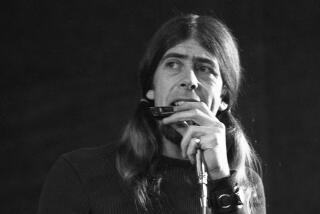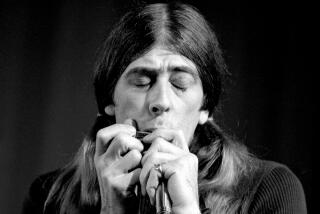John Mayall’s Blues : The ‘Godfather of British Blues’ says his music is his ‘own individual brand.’ And, it rocks.
- Share via
He’s made more discoveries than the heroine in a haunted house movie, except no one screams. They dance. This man’s discoveries are musical and he’s dug up more talent than Ted Mack. He’s John Mayall, veteran British bluesman who has been in L. A. since 1968. He might have shed his shoulder-length hair, but neither his accent nor his love for the blues.
Mayall will be cruising northward for a gig at the venerable Ventura Theatre for a Pearl Harbor Day concert Saturday. It won’t be as loud as 50 years ago, but a lot more fun. Mayall has been on the road for about 25 years, spreading his version of the rockin’ blues. Along with him have been his back-up band, in an ever-changing lineup, the Bluesbreakers.
“We try to limit ourselves to 120 gigs per year--we set that goal for ourselves,” Mayall said in a recent phone interview.
“We do around 16 countries every year, including a tour of Europe and also Japan, Australia and New Zealand. The Ventura show will probably be our last show before New Year’s.”
For a time in the mid-’60s, it seemed that every British rock ‘n’ roll band was a blues band. The Rolling Stones, the Yardbirds, Savoy Brown, Fleetwood Mac, Ten Years After, Love Sculpture were all white dudes doing the black blues thing electrically.
“It was just a phenomenon that happened--just one of those things out of the ‘60s,” Mayall said. “Also, everyone was very young then. I grew up listening to blues records. Most of those bands gradually found their own musical direction outside the blues, while a few have stayed true to the blues tradition. Blues and jazz have always been widely appreciated in Europe.”
Mayall, who has been called “The Godfather of British Blues,” released his first album in 1966. Some of the early Bluesbreakers included Eric Clapton and Jack Bruce, who went on to form Cream. Other Mayall accomplices included Andy Fraser, who founded Free, and Mick Taylor, the future Stones’ guitarist.
Peter Green, John McVie and Mick Fleetwood played with Mayall before they founded Fleetwood Mac. That’s right--before the women, the big hits and the big bucks--Fleetwood Mac was a blues-rock powerhouse with three lead guitarists.
“They made a lot of money doing the blues,” Mayall said.
With the number of ex-Bluesbreakers (nearly 100) reaching Wilt, Zsa Zsa and Liz proportions, the current lineup has been relatively stable. Guitarist Coco Montoya and drummer Joey Yuele have been in the band for eight years. Bass player Rick Cortes has been in the band a year. Mayall sings, plays keyboards and harmonica. “It’s blues, but it’s my own individual brand of blues,” he said. And it rocks.
And like mothers-in-law, the law and the IRS, blues never goes away. Along with reggae, both these genres seem to be getting stronger and stronger. There’s a blues band playing every night, it seems, in Ventura or Santa Barbara.
“I think blues is gaining in popularity,” Mayall said. “There are a lot of great musicians out there and the younger audiences seem to appreciate the blues more.”
But, according to Mayall, blues appreciation doesn’t necessarily extend to all record companies. He used to be signed with Island, he said, but the record firm decided to part company after Mayall’s 1990 album.
“Now my management and my agent are shopping for a new record deal. I’ve released 37 albums so far, not counting all the repackaged collections.”
Despite a repertoire longer than the obit column in a Chuck Norris movie, Mayall has but one gold record, “The Turning Point” from 1969. You won’t see him on MTV or hear him on the radio (unless he learns some Mariah Carey covers), but his reputation proceeds him.
“The thing I find most rewarding is the fact that there are so many people who do admire what I’ve stood for through the years,” he said.
“It’s never resulted in great commercial success, but artistic success is another matter altogether. . . . Plus I have the satisfaction of creating the music.”
More to Read
The biggest entertainment stories
Get our big stories about Hollywood, film, television, music, arts, culture and more right in your inbox as soon as they publish.
You may occasionally receive promotional content from the Los Angeles Times.










